
Video clips have been added for most figures. If you have difficulty following a description of how to make a string figure, look at the end of the description and click on Slow dial-up, Dial-up, or Broadband. To view the clips you will need Window's Media Player. For best viewing enlarge the view. If you want to view better quality clips, Right Click on the Dial-up or Broadband link (even if you don't have DSL or other high speed connection) and select "Save as" to download the clip to your computer for fast, high quality viewing anytime you want.
The following figures give some indication of the amazing variety that human ingenuity has produced. Figures are described in both a special language that some "serious" string figure students prefer to use (much as most math students prefer "2+5=7" to "add two to five and you'll get seven"), and in plain English. Someday you might want to learn String Figure Notation, but you don't need to. You will need to learn Position 1 and Opening A, as these are commonly used to begin figures.
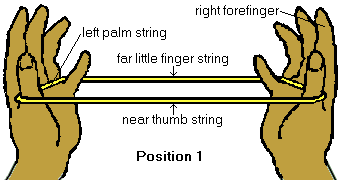
Position 1 (P1)
1 T pu SN:ex
2 L pu fTS:ex
Pick up one short section of the string loop on both thumbs without twisting it. Extend hands apart. The string now goes from one thumb to the next without any twists in it. The string closest to you is called the near thumb string, and the farthest one is called the far thumb string. Now, using your little fingers, pick up the far thumb strings on the fingernail side of the little fingers. (If told to grab a string, you would curl your finger around it and either hold it with the fingerprint side or, if instructed to, twist it 180 degrees towards or away from you as directed to take the string up on the finger or thumb.) Now just spread your hands and fingers apart to tighten the string and you have Position 1. View video: Slow dial-up, Dial-up, Broadband. For more details, click here.

Opening A (OA)
1 P1
2 rF ml-pu lPS:ex
3 lF mr-th rFN pu rPS:ex
 Do Position 1. Use your right forefinger to move left and pick up the left palm string on the back of the forefinger.
Do Position 1. Use your right forefinger to move left and pick up the left palm string on the back of the forefinger.
 Tighten the strings. The left forefinger then moves right, goes through the right forefinger noose, and picks up the right palm string. Unless told otherwise, tighten the strings after each step with palms facing each other, and fingers pointing up and spread apart.
Tighten the strings. The left forefinger then moves right, goes through the right forefinger noose, and picks up the right palm string. Unless told otherwise, tighten the strings after each step with palms facing each other, and fingers pointing up and spread apart.
View video: Slow dial-up, Dial-up, Broadband
Opening B is the same except you start with the left forefinger picking up the right palm string.
Here's what the strings in Opening A are called.
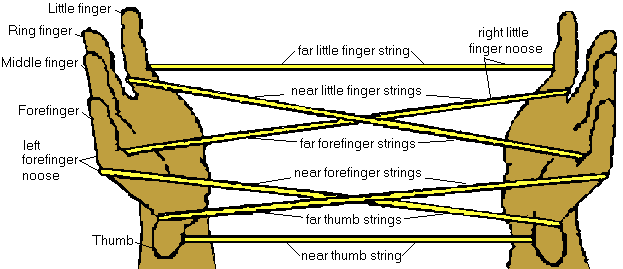
A Hand Catch
1 A:OA - B:rH mo-th FN
2 A:re L+F:OA - B:rH mu-th FN
3 A:re L+F:ex

Do Opening A. Hold your hands out towards someone. Have them put one hand through the center of the figure. (2) Now release the strings on both little fingers and forefingers, but keep the strings on the thumbs. You have now caught the other person's hand.
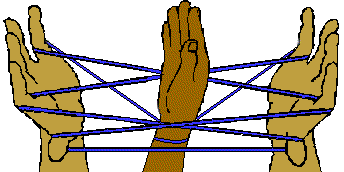 Do Opening A again with the far string still around the other person's wrist. Tell them to put their hand back up, from below, into the center of the figure. (3) Let go of the strings on your little fingers and forefingers again, and pull your thumbs apart. The string will go right through their arm!
Do Opening A again with the far string still around the other person's wrist. Tell them to put their hand back up, from below, into the center of the figure. (3) Let go of the strings on your little fingers and forefingers again, and pull your thumbs apart. The string will go right through their arm!
View video: Slow dial-up, Dial-up, Broadband
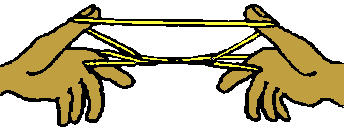
Cup & Saucer
Europe
1 OA
2 T mo nFS pu fFS (ex)
3 na T (Use M to re bnTS)
4 re L:ex T up
 Do Opening A. Move both your thumbs over the near forefinger strings and pick up both far forefinger strings (pulling the hands apart and strings tight is normally implied after each step).
Do Opening A. Move both your thumbs over the near forefinger strings and pick up both far forefinger strings (pulling the hands apart and strings tight is normally implied after each step).
 Now remove the lower of the two strings, the original thumb nooses, from both thumbs (navaho thumbs). You can remove each bottom string with the opposite hand, or you can use your middle fingers to remove the bottom near thumb string up and over the thumbs (at the same time) while leaving the upper string nooses in place (or use your mouth to remove the bottom near thumb string from the thumbs). Release both little fingers and extend thumbs up.
Now remove the lower of the two strings, the original thumb nooses, from both thumbs (navaho thumbs). You can remove each bottom string with the opposite hand, or you can use your middle fingers to remove the bottom near thumb string up and over the thumbs (at the same time) while leaving the upper string nooses in place (or use your mouth to remove the bottom near thumb string from the thumbs). Release both little fingers and extend thumbs up.
View 27 second video: Slow dial-up, Dial-up, Broadband
View 2:36 minute video with audio: Dial-up, Broadband
Several other very simple figures can be made from Cup and Saucer. Stretched out by bringing thumbs and forefingers closer together, the Cup can pass for A Boat on water. The Witch's Hat is made by taking the middle of the near thumb string (the top of the cup) in your mouth and pulling it out, without releasing the thumbs, until a large triangle is formed. The small forefinger nooses are the brims of the hat.  The Eiffel Tower is made in the same way, but thumbs are removed so the forefinger nooses are larger and resemble the base of the Eiffel Tower.
The Eiffel Tower is made in the same way, but thumbs are removed so the forefinger nooses are larger and resemble the base of the Eiffel Tower. 
View video: Slow dial-up, Dial-up, Broadband
From the Cup, thumbs can also be rotated away from you, down, and in front of the forefinger nooses so the thumbs are pointing down with palms out to create The Outrigger Canoe.
Laurel Sharp likes to do two more variations: Start with The Eiffel Tower and work your hands back and forth to collapse the figure into an upside down Y. Now put the nooses held in each hand on your ears and release the noose in your mouth so it hangs down in front of you. This is the The Stethoscope. Put your thumb in the hanging noose, tighten it, and put it against someone's chest (or your own), then rhythmically stroke the two strings. If one is a little tighter than the other, a very good "lub-dub, lub-dub" of a heart can be heard. Take the center of the "Y" and put it on your nose leaving the two nooses on your ears so that the remaining noose hangs from your nose. You have now made The Elephant's Nose.

The Star
Alaska (#4S)
1 Do Cup and Saucer
2 L pu tCSS:re T
3 T mo FN pu nLS:re rLN
Do Cup and Saucer using a short #4 string loop or a regular size loop that has been doubled. (2) Hold your hands with fingers pointing up. Look at the center of the figure where the bottom of the cup sits on the saucer. This part is made up of three strings. Two are crossed and go to the near side of the forefingers; the other is on top and loops around the far forefinger/far thumb strings.  Use your little fingers to pick up this top straight string as shown. Now release the strings on your thumbs. (3) With your thumbs move over the forefinger nooses and pick up the near little finger strings. Now release just the string noose on your right little finger. If the star doesn't look right, try using a shorter string.
Use your little fingers to pick up this top straight string as shown. Now release the strings on your thumbs. (3) With your thumbs move over the forefinger nooses and pick up the near little finger strings. Now release just the string noose on your right little finger. If the star doesn't look right, try using a shorter string.
This figure was collected by David Titus (March, 2001) while visiting with Yupik children from the village of Akiuk, Alaska. This figure appears to be a new invention. Most of the children in the village knew it (and many others). Even some of the Kindergarten kids could make much harder figures than The Star.
View video: Slow dial-up, Dial-up, Broadband
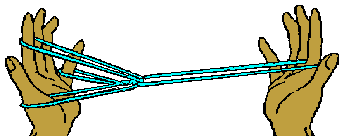
Fishing Spear
Pacific
1 P1:rF pu lPS ma-tw rFN
2 lF mr-th rFN pu rPS
3 re rTN+rLN (at same time)
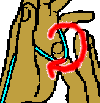 Do Position 1, then use the right forefinger to pick up the left palm string, but do not pull on this string yet. As your right hand returns to it starting position, the forefinger moves away from your body twisting the right forefinger noose 360 degrees. (2) The left forefinger then moves right, through the right forefinger noose, and picks up the right palm string just like in Opening A. (3) Release the right thumb and right little finger nooses at the same time. This figure is also called The Witch's Broom, or Turkey's Foot.
Do Position 1, then use the right forefinger to pick up the left palm string, but do not pull on this string yet. As your right hand returns to it starting position, the forefinger moves away from your body twisting the right forefinger noose 360 degrees. (2) The left forefinger then moves right, through the right forefinger noose, and picks up the right palm string just like in Opening A. (3) Release the right thumb and right little finger nooses at the same time. This figure is also called The Witch's Broom, or Turkey's Foot.
View video: Slow dial-up, Dial-up, Broadband
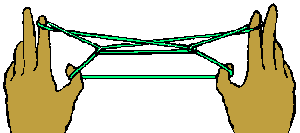
Dressing a Pelt
American Indian
1 OA:T ht nFS:re L, kl
2 fl hanging S out & over S
3 T ma-th TN gr fFS:ex qu
The game: See who can do this fastest.
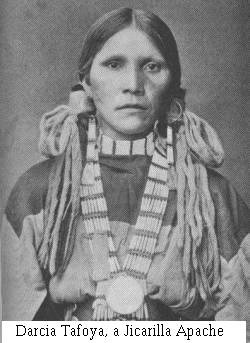
Do Opening A. Use your thumbs to hold the near forefinger strings tight against the forefingers. Release the little fingers, but keep the hanging string loose—do not extend. Flip the hanging string out away from you so that it goes up and over all the strings,  comes back towards you, and hangs over the near thumb string.
Now move the thumbs down and away from you so that they go through the thumb nooses and grab the far forefinger strings that are hanging over the thumb nooses. The original thumb strings will slip off. Extend the figure quickly.
comes back towards you, and hangs over the near thumb string.
Now move the thumbs down and away from you so that they go through the thumb nooses and grab the far forefinger strings that are hanging over the thumb nooses. The original thumb strings will slip off. Extend the figure quickly.
The pulling through of the string reminded American Indians of pulling off the skin of a hanging animal and reversing it as it was being dressed out. The figure is difficult to do quickly in one smooth motion, so competing to see who can do it the fastest is a fun game to play. Note that this figure is an upside down Cup and Saucer and can be made the same way by reversing references to thumb and little finger in the instructions for making Cup and Saucer.
View video: Slow dial-up, Dial-up, Broadband

A Moth
Zulu (Use #5S or #6S)
1 OA:re T
2 T mo FN pu nLS:re L
3 T pu nFS:na T (using M)
4 F md-gr TFNtS ma-ex F up
Do Opening A using a short #5 or #6 string. Release thumb strings. (2) Thumbs then move over the forefinger strings and pick up the near little finger strings. Release the strings on the little fingers. 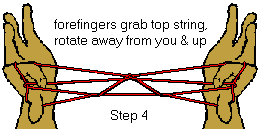 (3) Thumbs next pick up the near forefinger strings. Now remove (navaho) the lower thumb strings (which is easiest to do using the middle fingers to lift them off and over the thumbs while leaving the upper thumb strings in place). (4) Forefingers move down and grab the top string that goes around the middle of the thumb/forefinger noose, then, moving away from you, extend the forefingers up and palms out.
(3) Thumbs next pick up the near forefinger strings. Now remove (navaho) the lower thumb strings (which is easiest to do using the middle fingers to lift them off and over the thumbs while leaving the upper thumb strings in place). (4) Forefingers move down and grab the top string that goes around the middle of the thumb/forefinger noose, then, moving away from you, extend the forefingers up and palms out.
View video: Slow dial-up, Dial-up, Broadband
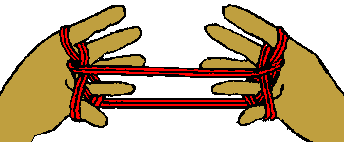
The Mouth
Pacific
1 Double SN, or use #4S:P1
2 F pu fLS
3 T mo nFS pu fLS:na T
4 Open and close T&F to make mouth talk
Double up a normal #8 string or use a short #4 or #5 string, and do Position 1. (2) Forefingers pick up the far little finger string. (3) Thumbs then move over the near forefinger strings and pick up the far little finger strings (which could also be called the far forefinger strings) and remove the lower thumb strings (or simply let the original thumb string slip off as you pull the far little finger string through). (4) Open and close your thumbs and forefingers to make the mouth talk. Cover your mouth with your forearm and give the mouth a voice.
This figure is also called Crab's Mouth, but the Hawaiians think it looks more like the twitching posterior of a pig.
View video: Slow dial-up, Dial-up, Broadband
You can also release your little fingers and turn thumb and forefingers pointing away from you to create The Bone.
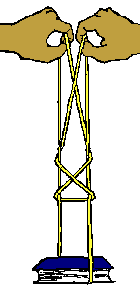
Man Climbing a Tree
Australia (#8-12S)
1 OA:L mo S pu nTS
2 F gr-ht PS:re bLN
3 re TN (ls bFN over F)
4 de fLS (use foot, etc.)
5 ex H up:ls FS & man climbs the tree
Do Opening A. Little fingers then move over all strings and pick up the near thumb strings on the tips of the little fingers to keep it separate from the original string. (2) Grab and hold tight the palm strings with the forefingers, then remove the bottom little fingers noose (holding the top string with your middle fingers while letting the lower string slip off). (3) Release the thumb nooses while letting the bottom forefinger noose slip over the forefinger. (4) Depress the far little finger string using your foot, a book, etc. (5) Extend hands upward while letting the forefingers alternately slip to see the man climbing a tree.
View video: Slow dial-up, Dial-up, Broadband
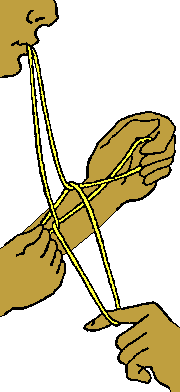
Sawing Wood
U.K.
1 FMRL pu SN:tw nHS ar H
2 F do OA:O ht nHSS
3 Person B ht fHSS
4 F ma-gr FN, ls HN:Saw wood.
Variation 1
Person A: OA
Person B: rT&L pu A's nTS:lT&L pu A's fTS, now do OA over A's S
A&B: re T & L:Saw wood
Variation 2
A&B: T & L pu SN:rH OA, then lH OA over rHS:
re T&L:Saw wood
Use all four fingers to pick up the string noose—the near hand string goes between the thumb and forefinger. Grab the near hand string close to the thumb with the opposite hand and twist it around the hand, then do the same for the other hand. (You could also grab the near hand string with all fingers and twist the string up onto the hands in one motion.) There is now a palm string and two dorsal strings across the back of your hands. (2) Use the forefingers to pick up the palm strings as you would in doing Opening A. Use your mouth or teeth to hold on to the center of the near hand string that goes straight across from hand to hand. (3) Have a second person grab the straight string on the far side of your hand. (4) Turn your forefingers away from you, bend them down and grab the noose that goes around the forefingers while letting the strings going around your hand slip off. Pull both hands apart, then let the other person pull their string, then you pull your strings, and so on, to saw wood.
View video: Slow dial-up, Dial-up, Broadband
Variation 1: You, as person A, makes Opening A. Person B then picks up your near thumb string on their right thumb and little fingers as in Position 1, and likewise they take up your far little finger string with their left thumb and little finger. Person B then does Opening A over your strings. Both of you then release your thumb and little finger strings while holding on to your forefinger strings. Now you can saw wood vigorously without pulling any teeth out.
Variation 2: Two people take up the string loop as in Position 1 with your palms facing theirs. You will share far little finger strings in common. Now each of you, using only your right hands, do Opening A. Next use your left hands to do Opening A over top of your right hand strings. Both of you then release your thumb and little fingers and saw wood by alternately pulling right then left hands.
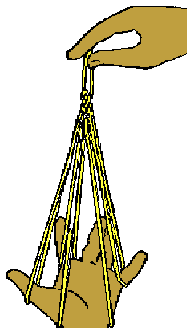
Framework for a Hut
Africa
1 lH P1:rH ml-th SN mu lH:rTF mt-ht ldTS
2 rTF gr-pt ldTS tr to lF (no tw)
3 rTF ht lPSnL tr to lT
4 rTF mo lH ht-re ldHS & ex up
Take up Position 1 on the left hand only. With the right hand, move left and through the hanging string noose, then reach around to the back of the left hand. With your right thumb and forefinger grasp the string going across the back of the left thumb. (2) Now pull this string down and through the hang string noose just far enough to transfer it to the left forefinger without twisting it. (3) With your right thumb and forefinger hold tight to the  left palm string near the left little finger and transfer it to the left thumb. (4) Again, using your right thumb and forefinger, move over top of the left hand, reach around to the back of the left hand and grab the string going around the back of the left hand. Pull this string out and over the left hand to remove it, and then slowly extend your right hand up while letting the strings on the left hand slip to raise the framework for a hut (or teepee?)
left palm string near the left little finger and transfer it to the left thumb. (4) Again, using your right thumb and forefinger, move over top of the left hand, reach around to the back of the left hand and grab the string going around the back of the left hand. Pull this string out and over the left hand to remove it, and then slowly extend your right hand up while letting the strings on the left hand slip to raise the framework for a hut (or teepee?)
View video: Slow dial-up, Dial-up, Broadband
You can turn this figure upside down so that the left hand becomes The Parachute with its cords holding up the parachutist.

The Mouse
World Wide
1 lTFMRL pu SN, lP down with SN hanging
2 rF ma-pu lnTS ml-bt lT&F gr-pt lTFS, mt-tw & tr rFN to lF
(do not ex)
3 rF mu-pu lPS ml-bt lFM gr-pt ldHS, mt-up-tr rFN to lM:repeat for lR & lL
4 re lT:rTF ht lnLSnL & pull:Mouse runs bt FRML
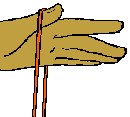 With the left hand held with the palm down, hang the string noose over the left thumb and fingers.
With the left hand held with the palm down, hang the string noose over the left thumb and fingers.
 (2) With your right forefinger, move away from you and pick up the left near hanging thumb string, then move left, going between the thumb and forefinger, and grab the string going across the back of the left thumb and forefinger.
(2) With your right forefinger, move away from you and pick up the left near hanging thumb string, then move left, going between the thumb and forefinger, and grab the string going across the back of the left thumb and forefinger.
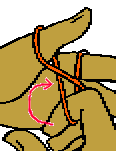
 Pull this string a short distance out, then twist your right forefinger towards you to bring it to the normal upright position, but do not extend hands apart.
Pull this string a short distance out, then twist your right forefinger towards you to bring it to the normal upright position, but do not extend hands apart.
 Instead touch your right forefinger to the left forefinger and transfer the noose from the right forefinger to the left forefinger.
Instead touch your right forefinger to the left forefinger and transfer the noose from the right forefinger to the left forefinger.
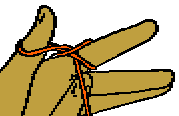 (3) Now take your right forefinger and, moving away from you, pick up the left hanging palm string. As before, move left, going between the forefinger and middle finger, and grab the string going across the back of the left hand.
(3) Now take your right forefinger and, moving away from you, pick up the left hanging palm string. As before, move left, going between the forefinger and middle finger, and grab the string going across the back of the left hand.
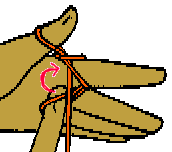
 Pull this string a short distance out, then twist your right forefinger towards you to bring it to the normal upright position without extending hands apart. Transfer this noose to the left middle finger by touching the tip of it with your right forefinger and letting the noose slip onto it. Repeat this pattern for the left ring and little fingers.
Pull this string a short distance out, then twist your right forefinger towards you to bring it to the normal upright position without extending hands apart. Transfer this noose to the left middle finger by touching the tip of it with your right forefinger and letting the noose slip onto it. Repeat this pattern for the left ring and little fingers.
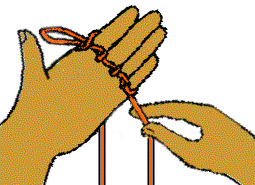 (4) Release the left thumb. This noose is the mouse. Attack the mouse with your left thumb while pretending it is a snake. With your right thumb and forefinger grab the left near little finger string that hangs down just below the left little finger and pull the string so the mouse can make its escape by running away through the trees.
(4) Release the left thumb. This noose is the mouse. Attack the mouse with your left thumb while pretending it is a snake. With your right thumb and forefinger grab the left near little finger string that hangs down just below the left little finger and pull the string so the mouse can make its escape by running away through the trees.
View video: Slow dial-up, Dial-up, Broadband
This figure is also known as The Yam Thief and many stories can be told about what is going on. One story is about a row of birds sitting on a fence and suddenly taking flight. Another is about a cat and a mouse. Another is about a strong but stupid man trying to pull up a root by pulling before the thumb is released. The clever village weakling then releases the thumb and easily pulls up the root to the amazement of all. So make up your own story.
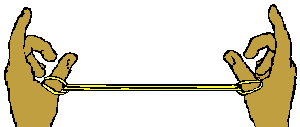
Thumb Catch
Pacific
1 lH P1:rL ml-mt-pu lnTS, ex
2 rT pu rnLS:OA:T mo-th FN md-mt-up
3 re FN:re L, ex
Start with Position 1 using the left hand only. The right little finger then moves left, through the hanging string noose, and picks up the left near thumb string. Extend hands apart. (2)  The right thumb then picks up the right near little finger string. This is a twisted Position 1. Now do Opening A.
The right thumb then picks up the right near little finger string. This is a twisted Position 1. Now do Opening A. 
 The thumbs then move over, through the forefinger noose, down, toward you, then up. (3) Release the forefinger nooses, then release the little fingers and extend to catch the thumbs in a snare.
The thumbs then move over, through the forefinger noose, down, toward you, then up. (3) Release the forefinger nooses, then release the little fingers and extend to catch the thumbs in a snare.
View video: Slow dial-up, Dial-up, Broadband
If, before you release your little fingers, you put all fingers from below into the thumb nooses and transfer them to the wrists, then release your little fingers, you will have made The Handcuffs. Alternatively, transfer only one thumb noose to your wrist and hold the other open with your fingers, then ask an innocent bystander to put their hand through it. Release little fingers to cuff and arrest them.

Batoka Gorge
Africa on Zambesi River
1 Drape SN over rW, separate S
2 lH mr-th SN, ex
3 L pu 2CS
4 fl nWSS over H
5 T pu nLS:re WN
Drape the string loop over your right wrist keeping the two strings separated without any twists. (2) The left hand then moves to the right and through the two hanging string nooses. Extend hands apart. There should be two crossed strings, and a near and far wrist string. (3) The little fingers pick up first the far then the near crossed strings. (4) Now flip the near wrist string that goes straight across up and over the hands. The near little finger strings run diagonally down to the far wrist string. (5) Pick up these near little finger strings on the thumbs, and then remove the wrist nooses.
View video: Slow dial-up, Dial-up, Broadband
This is a nice African figure, but for most of us who have never been to Batoka Gorge on the Zambesi River below Victoria Falls, it doesn't quite look like a gorge. The figure is said to look like the river as it zigzags back and forth through Batoka Gorge below the falls. If you want to invent new names for figures, that's okay.
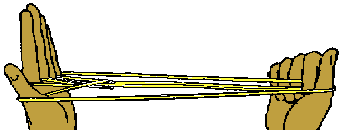
Casting a Spear
Africa, Pacific
1 OA
2 lF mo-pu rFN, rF mo-th-pu lbFN
3 re rF to cast the spear
4 rF mu-th lFN pu released N
5 re lF to cast again, repeat...
Do Opening A.  (2) Left forefinger picks up the right forefinger noose from above on the tip of the finger removing it from the right forefinger, then the right forefinger moves over the back of the left forefinger and picks up the original, bottom left forefinger string removing it from the left forefinger.
(2) Left forefinger picks up the right forefinger noose from above on the tip of the finger removing it from the right forefinger, then the right forefinger moves over the back of the left forefinger and picks up the original, bottom left forefinger string removing it from the left forefinger. 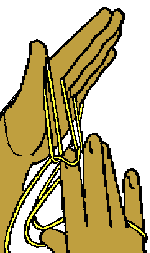 The left forefinger noose now goes through and around the right forefinger noose. (3) Release the right forefinger to cast the spear while holding the right far thumb string and right near little finger string close together to form the shaft of the spear which has three points on the other side (making it a fishing spear). (4) Now with your right forefinger go from below up into the left forefinger noose and pick up the original right forefinger string. (5) Release the left forefinger this time to cast the spear the other way. Again pick up the released noose and cast again and again.
The left forefinger noose now goes through and around the right forefinger noose. (3) Release the right forefinger to cast the spear while holding the right far thumb string and right near little finger string close together to form the shaft of the spear which has three points on the other side (making it a fishing spear). (4) Now with your right forefinger go from below up into the left forefinger noose and pick up the original right forefinger string. (5) Release the left forefinger this time to cast the spear the other way. Again pick up the released noose and cast again and again.
View video: Slow dial-up, Dial-up, Broadband
![]()
- Visit our Zazzle store:
Fine poetry and art go together. Support this site: Visit our Zazzle store featuring ultra hi-res images of artworks, Hubble/ESA/NASA space images, Mandelbrot fractals, maps and more. Images up to 525 megapixels allow for fine printing at the largest sizes. Give a fine print as a gift that could hang around for a hundred years or more.
Other sites by Alysion
Popular Sites:- Fun with Dimensional Analysis
- Medication Math for the Nursing Student
- WWW Collection of Favorite String Figures
- Poems to Memorize & Memorable Poems
- Alternative Handwriting & Shorthand Systems
- Handywrite
- Small Animal Euthanasia
- Ryan's Favorite Kid Poems
- World's Funniest Jokes
Mindfulness Sites:
- For wisdom follow: The Path of the Dog
- Are You a Doggiesattva?
- The Five Precepts of Buddhism
- The Diamond Sutra: Condensed version
- The Platform Sutra of Huineng: Condensed
- The Tibetan Book of the Great Liberation
- Ch'an Teachings of Huang Po on One Mind
- Zen and the Art of Mindful Bus Riding
- Beginnings: First Lines from Scriptures
- Two Zen Stories
- 14 Mindfulness Trainings of Thich Nhat Hanh
- 14 Thoughtfulness Trainings
- Westfulness and Eastfulness
- World Religion Simplified
- Mindfulness Meditation Bell, Gong, Timer
Thrival Sites:
- Buyer's Guide to Food Preparedness Products
- Sustainability Issues: From vision to practice
- Survival Retreat? Maybe now is the time
- Battling Bermudagrass
- Human Chow: Cheap Food
- Private Retreat: Alysion Acres
Sustainability Issues:
- Earth at Night: Do you live in the glow?
- Environment, Power, and Society
- The Prosperous Way Up and Down
- Circles of Non-belief: The Federation alternative
- Envision Tucson Sustainable
- Community Urban Micro Farms
- Alternative Farming
- Washing Machine Magic
- Eco-nomy 101: Why you can't do just one thing
- Confessions of a Generalist
- The Post-Car Culture
- Rainwater Catchment: How to harvest scarcity
- Stop Pumping Ground Water
- From Horses to E-cycles: A brief history
- Sustainable Tucson: Hows to sustain
- Ethics of the Borg Collective
- Alternative to the Federation
- Cruise Ship Earth: Enjoy the cruise
- Expecting the Expected: Disaster happens
- Understanding the Exponenital Function
- A Tale of Two Islands
- Island Ethics: Earth Island as metaphor
- The Book: From beyond the Federation
- The Ascent of Life: Chapter 1
- Apocalypse Past: Chapter 2
- The Reconstruction Era: Chapter 3
- The Particulars of Human Life: Chapter 4
- Ascent of the Inquiring Ones: Chapter 5
Satirical Sites:
- Take the Super Post-Mensa IQ Test
- Infidel Guides: Islam, Theism, Atheism, ...
- World Religions Simplified
- The True Right to Life Movement
Literature/Poetry Sites:
- Mom's Favorite Poems
- Lorien: A Poem
- Ryan's Favorite Kid Poems
- Tucson Literati Discussion Group
- Walled-in: A Poem
- Poems to Memorize & Memorable Poems
Interesting Sites:
- Sun Tour America by Solar E-bike
- Sustainable Technology to Enable
- Grammys Urban Micro Farm
- Solar Slow Cooker Design
- Celebrate Inquiry
- Pastaology 101
- Flying Spaghetti Monster Camp
- The Book: An Infidel's Biblia
- Global Warming 123 (bing-bang-boom)
- How to Use OpenSeaDragon
- Battling Bermuda Grass
- San Pedro Valley Community Cultural Center
- One Homestead: An intentional community
- Making Tree of Life: Fun with phylogenetics
- Making Boxes for Rock & Mineral Collection
- Making a Mass Balance Scale
- Ryan's 50 States Flashcards
- Adventures of MeraLee
- eBike Touring Association
- Cochise Stronghold Trail
External Links
- International String Figure Association
- Learn about string figuring.
- Strings on Your Fingers
- Bibliography, Links, Resources.
- String Figures
- The Wikipedia article.
- Arctic String Figure Project
- Lots of figures here with great illustrations.
- String Figures, Mathematics, Origin
- Some original figures.
- String Figures by Brian Cox
- The Incredible String Man.
Top 10 Poems from Alysion's
Bucket List of Poems
to Read Before You Die
- 1. The Rainy Day by Henry W. Longfellow
- 2. Fire and Ice by Robert Frost
- 3. A Dream within a Dream by Edgar Allan Poe
- 4. The Purple Cow by Gelett Burgess
- 5. If by Rudyard Kipling
- 6. To See a World by William Blake
- 7. Ten Little Limericks
- 8. First Fig by Edna St. Vincent Millay
- 9. Alone by Edgar Allan Poe
- 10. I'm nobody! Who are you? Emily Dickinson

